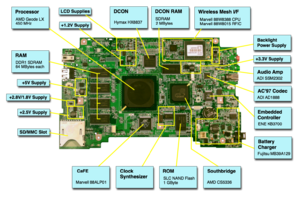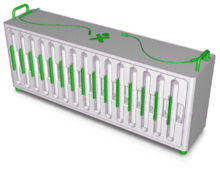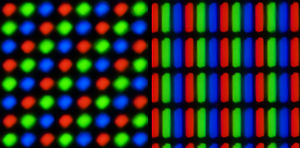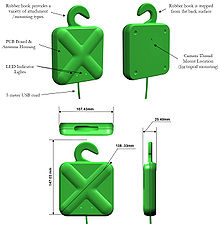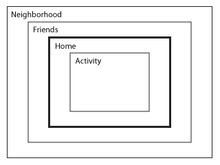- OLPC XO-1
-
XO-1 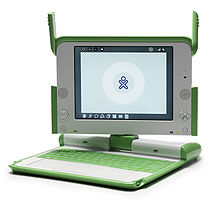
Manufacturer Quanta Computer Media 1 GB flash memory Operating system Fedora-based (Linux) CPU AMD Geode LX700@0.8 W + 5536 Memory 256 MB DRAM Display dual-mode (backlit color/direct-sunlight grayscale) 19.1 cm/7.5" diagonal TFT LCD 1200×900 Input Keyboard
Touchpad
Microphone
CameraCamera built-in video camera (640×480; 30 FPS) Connectivity 802.11b/g /s wireless LAN
3 USB 2.0 ports
MMC/SD card slotDimensions 242 mm × 228 mm × 32 mm Weight LiFePO4 battery: 1.45 kg [3.2 pounds]; NiMH battery: 1.58 kg (3.5 pounds) The XO-1, previously known as the $100 Laptop[1], Children's Machine[2], and 2B1[3], is an inexpensive subnotebook computer intended to be distributed to children in developing countries around the world,[4] to provide them with access to knowledge, and opportunities to "explore, experiment and express themselves" (constructionist learning).[5] The laptop is developed by the One Laptop per Child (OLPC) non-profit, 501(c)(3) organization and manufactured by Quanta Computer.
The subnotebooks are designed for sale to government-education systems which then give each primary school child their own laptop. Pricing was set to start at $188 in 2006, with a stated goal to reach the $100 mark in 2008 and the 50-dollar mark by 2010.[6] When offered for sale in the Give One, Get One campaigns of Q4 2006 and Q4 2007, the laptop was sold at $199.[7]
These rugged, low-power computers use flash memory instead of a hard drive, and come with a distribution of Linux derived from Red Hat's Fedora as their pre-installed operating system.[8] Mobile ad-hoc networking via 802.11s WiFi mesh networking protocol is used to allow many machines to share Internet access as long as at least one of them can see and connect to a router or other access point.
The XO-1 is also nicknamed ceibalita in Uruguay after the Ceibal project.[9]
Contents
History
Main article: One Laptop per ChildThe first early prototype was unveiled by the project's founder Nicholas Negroponte and then-United Nations Secretary-General Kofi Annan on November 16, 2005, at the World Summit on the Information Society (WSIS) in Tunis, Tunisia.[10] The device shown was a rough prototype using a standard development board. Negroponte estimated that the screen alone required three more months of development.[citation needed] The first working prototype was demonstrated at the project's Country Task Force Meeting on May 23, 2006.[citation needed]
In 2006 there was a major controversy because Microsoft had suddenly developed an interest in the XO project and wanted the formerly open source effort to run Windows. Negroponte agreed to provide engineer assistance to Microsoft to facilitate their efforts. During this time, the project mission statement changed to remove mentions of "open source". A number of developers, such as Ivan Krstić and Walter Bender, resigned because of these changes in strategy.[11][12][13] As of 2011[update], however, no laptops have ever shipped by OLPC with Windows installed.
Approximately 400 developer boards (Alpha-1) were distributed in mid-2006; 875 working prototypes (Beta 1) were delivered in late 2006; 2400 Beta-2 machines were distributed at the end of February 2007;[14] full-scale production started November 6, 2007.[15] Quanta Computer, the project's contract manufacturer, said in February 2007 that it had confirmed orders for one million units. Quanta indicated that it could ship five million to ten million units that year because seven nations had committed to buy the XO-1 for their schoolchildren: Argentina, Brazil, Libya, Nigeria, Rwanda, Thailand, and Uruguay.[16] Quanta plans to offer machines very similar to the XO-1 on the open market.[17]
The OLPC project originally stated that a consumer version of the XO laptop was not planned.[18] The project later established, in 2007 the laptopgiving.org website for outright donations and for a "Give 1 Get 1" offer valid (but only to the United States, its territories, and Canadian addresses) from November 12, 2007 until December 31, 2007.[19] For each computer purchased at a cost of $399, an XO is also sent to a child in a developing nation.[19] OLPC again restarted the G1G1 program through Amazon.com in November 2008, but has since stopped as of December 31 (2008 or 2009).[20]
On May 20, 2008, OLPC announced the next generation of XO, OLPC XO-2[21] which was thereafter cancelled in favor of the tablet-like designed XO-3. In late 2008, the NYC Department of Education began a project to purchase large numbers of XO computers for use by New York schoolchildren.[22]
The design received the Community category award of the 2007 Index: Award.[23][24]
According to Computer Aid International, in a test conducted in April 2009, the device was ranked as the most power saving among other information and communication technologies in education solutions.[25]
Design
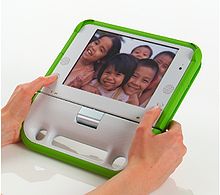 OLPC XO-1 laptop in Ebook-Mode.
OLPC XO-1 laptop in Ebook-Mode.
The XO-1 is designed to be low-cost, small, durable, and efficient. It is shipped with a slimmed-down version of Fedora Linux and a GUI called Sugar that is intended to help young children collaborate. The XO-1 includes a video camera, a microphone, long-range Wi-Fi, and a hybrid stylus/touch pad. In addition to a standard plug-in power supply, human power and solar power sources are available, allowing operation far from a commercial power grid. Mary Lou Jepsen has listed the design goals of the device as follows:[26]
- minimal power consumption, with a design target of 2–3 W total power consumption
- minimal production cost, with a target of US$100 per laptop for production runs of millions of units
- a "cool" look, implying innovative styling in its physical appearance
- e-book functionality with extremely low power consumption
- open source and free software provided with the laptop
Various use models had been explored by OLPC with the help of Design Continuum and Fuseproject, including: laptop, e-book, theatre, simulation, tote, and tablet architectures. The current design, by Fuseproject, uses a transformer hinge to morph between laptop, e-book, and router modes.[citation needed]
Hardware
The latest GA version of the XO-1 is XO 1.5. The specs for older builds are documented in the Major Builds section, below. Data about the XO-1 comes from the hardware specification.[27]
- XO 1
- CPU: 433 MHz AMD Geode LX-700 at 0.8 watts, with integrated graphics controller
- 256 MB of Dual (DDR266) 133 MHz DRAM (in 2006 the specification called for 128 MB of RAM)[28]
- 1024 kB (1 MB) flash ROM with open-source Open Firmware
- 1024 MB of SLC NAND flash memory (in 2006 the specifications called for 512 MB of flash memory)[29]
- XO 1.5[30]
- Release Date 2010
- CPU: 400 MHz to 1000 MHz VIA C7 at 0.8 watts, with integrated graphics controller in ebook mode
- 512 to 1024 MB of Dual (DDR266) 133 MHz DRAM
- 1024 kB (1 MB) flash ROM with open-source Open Firmware
- 4 GB of SLC NAND flash memory
- XO 1.75[31] [32]
- Release Date TBD Mid 2011 ?
- CPU: 400 MHz to 1000 MHz ARM architecture Marvell 1GHz Armada 610 ARM chip at 0.8 watts, with integrated graphics controller in ebook mode
- 1024 TBD MB of DDR3
- 1024 TBD kB (1 MB) flash ROM with open-source Open Firmware
- 4 GB of SLC NAND flash memory
- Screen
- 1200×900 7.5 inch (19 cm) diagonal LCD (200 dpi) that uses 0.1 to 1.0 W depending on mode. The two modes are:
- Reflective (backlight off) monochrome mode for low-power use in sunlight. This mode provides very sharp images for high-quality text.
- Backlit color mode, with an alternance of red,green and blue pixels. See below for details.
- XO 1.75 developmental version for Xo-3 has touch screen
- 1200×900 7.5 inch (19 cm) diagonal LCD (200 dpi) that uses 0.1 to 1.0 W depending on mode. The two modes are:
- Storage
- Internal SD card slot[33]
- Wireless
- Wireless networking using an “Extended Range” 802.11b/g and 802.11s (mesh) Marvell 8388 wireless chip, chosen due to its ability to autonomously forward packets in the mesh even if the CPU is powered off. When connected in a mesh, it is run at a low bitrate (2 Mbit/s) to minimize power consumption. Despite the wireless chip's minimalism, it supports WPA.[34] An ARM processor is included.
- Dual adjustable antennas for diversity reception.
- Inputs/Ports
- Water-resistant membrane keyboard, customized to the locale in which it will be distributed.[35] The multiplication and division symbols are included. The keyboard is designed for the small hands of children.
- Five-key cursor-control pad; four directional keys plus Enter
- Four "Game Buttons" (functionally PgUp, PgDn, Home, and End) modeled after the PlayStation controller layout (
 ,
,  ,
,  , and
, and  ).
). - Touchpad for mouse control and handwriting input
- Built-in color camera, to the right of the display, VGA resolution (640×480)
- Built-in stereo speakers
- Built-in microphone
- Audio based on the AC'97 codec, with jacks for external stereo speakers and microphones, Line-out, and Mic-in
- 3 external USB 2.0 ports.
- Power sources:
- DC input, ±11–18 V, maximum 15 W power draw
- 5-cell rechargeable NiMH battery pack, 3000 mAh minimum 3050 mAh typical 80% usable, charge at 0…45°C
- 2-cell rechargeable LiFePO4 battery pack, 2800 mAh minimum 2900 mAh typical 100% usable, charge at 0…60°C
- 4-cell rechargeable LiFePO4 battery pack, 3100 mAh minimum 3150 mAh typical 100% usable, charge at −10…50°C
- External manual power options include a pull-string generator designed by Potenco[36], and a clamp-on crank generator similar to the original built-in one (see photo in the Gallery, below).
- External power options include 110–240 Volt AC as well as input from an external solar panel[37]
Major builds
XO 1 has major builds indicated by build numbers or less-than-one increments of the version number. The changes made in each build are to be documented in this section. Other versions (OLPC XO-3) are documented in other articles.
The hardware specifications that were different in older versions of the XO-1 are listed below.
- XO 1.0 beta, displayed in 2007.
- Power options: Battery and built-in hand-crank generator.
- XO 1.5. Released in 2009.
- Via/x86 CPU 4.5 W
- Fewer physical parts
- Lower power consumption
- Hand-crank generator is an optional peripheral.
- XO 1.75. Released in TBD Mid 2011. Slated to have:
- 2 Watt ARM CPU
- Fewer physical parts, lower power consumption. Hand-crank generator is an optional peripheral, 1 min of cranking = Color 10 min, B&W 12 Min of use.[39]
- XO 2. Previously scheduled for release in 2010, canceled in favor of XO 3. Price target $75. Elegant, lighter, folding dual touch-screen design (See photo in the Gallery section, below). Hardware would have been open-source and sold by various manufacturers. Choice of OS (Windows XP or Linux) outside of the US. $150 price target in the USA includes 2 computers, one donated.[40]
- XO 3. Scheduled for release in 2012 or later. One solid color multi-touch screen design. See full article, OLPC XO-3.
Intentionally omitted features
In keeping with its goals of robustness and low power consumption, the design of the laptop intentionally omits all motor-driven moving parts; it has no hard drive, no optical (CD/DVD) media, no floppy drives and no fans (the device is passively cooled). An ATA interface is unnecessary due to the lack of hard drive. There is also no PC card slot, although an SD slot is available, as well as USB ports.
A built-in hand-crank generator was part of the notebook in the original design, however it is now an optional clamp-on peripheral (See a photo in the Gallery, below).[29]
Power consumption
The laptop design specification goals are consumption of about 2 W of power during normal use, far less than the 10 W to 45 W of conventional laptops.[14] With build 656, power consumption is between 5 and 8 watts measured on G1G1 laptop. Future software builds are expected to meet the 2-watt target.
In e-book mode (XO 1.5), all hardware sub-systems except the monochrome dual-touch display are powered down. When the user moves to a different page, the other systems wake up, render the new page on the display, and then go back to sleep. Power consumption in this e-book mode is estimated to be 0.3 to 0.8 W. The XO 2.0 is planned to consume even less power than earlier versions, less than 1.0 W in full color mode.
Power options include batteries, solar power panels, pull-string generators, and clamp-on hand-crank generators, which make the XO self-powered equipment. 10 batteries at once can be charged from the school building power in the XO multi-battery charger (see photo). The low power consumption combined with these power options are very useful in many countries that lack a power infrastructure where students would use it.
Display
The first-generation OLPC laptops have a novel low-cost LCD. Later generations of the OLPC laptop are expected to use low-cost, low-power and high-resolution color displays with an appearance similar to electronic paper.
The display is the most expensive component in most laptops. In April 2005, Negroponte hired Mary Lou Jepsen—who was interviewing to join the Media Arts and Sciences faculty at the MIT Media Lab in September 2008[41]—as OLPC Chief Technology Officer. Jepsen developed a new display for the first-generation OLPC laptop, inspired by the design of small LCDs used in portable DVD players, which she estimated would cost about $35. In the OLPC XO-1, the screen is estimated to be the second most expensive component (after the CPU and chipset).[42]
Jepsen has described the removal of the filters that color the RGB subpixels as the critical design innovation in the new LCD. Instead of using subtractive color filters, the display uses a plastic diffraction grating and lenses on the rear of the LCD to illuminate each pixel.[dubious ] This grating pattern is stamped using the same technology used to make DVDs. The grating splits the light from the white backlight into a spectrum. The red, green and blue components are diffracted into the correct positions to illuminate the corresponding pixel with R, G or B. This innovation results in a much brighter display for a given amount of backlight illumination: while the color filters in a regular display typically absorb 85% of the light that hits them, this display absorbs little of that light. Most LCD screens use cold cathode fluorescent lamp backlights which are fragile, difficult or impossible to repair, require a high voltage power supply, are relatively power-hungry, and account for 50% of the screens' cost (sometimes 60%). The LED backlight in the XO-1 is easily replaceable, rugged, and inexpensive.[43][44]
The remainder of the LCD uses existing display technology and can be made using existing manufacturing equipment. Even the masks can be made using combinations of existing materials and processes.
Display resolution
When lit primarily from the rear with the white LED backlight, the display shows a color image composed of both RGB and grayscale information.[45] When lit primarily from the front by ambient light, for example from the sun, the display shows a monochromatic (black and white) image composed of just the grayscale information.
"Mode" change occurs by varying the relative amounts backlight and ambient light. With more backlight, a higher chrominance is available and a color image display is seen. As ambient light levels, such as sunlight, exceed the backlight, a grayscale display is seen; this can be useful when reading e-books for an extended time in bright light such as sunlight. The backlight brightness can also be adjusted to vary the level of color seen in the display and to conserve battery power.
In color mode (when lit primarily from the rear), the display does not use the common RGB pixel geometry for liquid crystal computer displays, in which each pixel contains three tall thin rectangles of the primary colors. Instead, the XO-1 display provides one color for each pixel. The colors align along diagonals that run from upper-right to lower left (see diagram on the right). To reduce the color artifacts caused by this pixel geometry, the color component of the image is blurred by the display controller as the image is sent to the screen. Despite the color blurring, the display still has high resolution for its physical size; normal displays as of February 2007[update] put about 588(H)×441(V) to 882(H)×662(V) pixels in this amount of physical area[citation needed] and support subpixel rendering for slightly higher perceived resolution. A Philips Research study measured the XO-1 display's perceived color resolution as effectively 984(H)×738(V).[46][47][48] A conventional liquid crystal display with the same number of green pixels (green carries most brightness or luminance information for human eyes) as the OLPC XO-1 would be 693×520.[citation needed] Unlike a standard RGB LCD, resolution of the XO-1 display varies with angle. Resolution is greatest from upper-right to lower left, and lowest from upper-left to lower-right. Images which approach or exceed this resolution will lose detail and gain color artifacts. The display gains resolution when in bright light; this comes at the expense of color (as the backlight is overpowered) and color resolution can never reach the full 200 dpi sharpness of grayscale mode because of the blur which is applied to images in color mode.
Wireless mesh networking
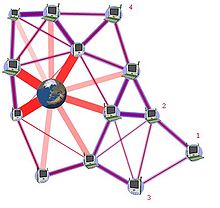 XO-1 Internet access through wireless mesh networking
XO-1 Internet access through wireless mesh networking
IEEE 802.11b support will be provided using a Wi-Fi “Extended Range” chip set. Jepsen has said the wireless chip set will be run at a low bit rate, 2 Mbit/s maximum rather than the usual higher speed 5.5 Mbit/s or 11 Mbit/s to minimize power consumption. The conventional IEEE 802.11b system only handles traffic within a local cloud of wireless devices in a manner similar to an Ethernet network. Each node transmits and receives its own data, but does not route packets between two nodes that cannot communicate directly. The OLPC laptop will use IEEE 802.11s to form the wireless mesh network.
Whenever the laptop is powered on it will participate in a mobile ad-hoc network (MANET) with each node operating in a peer-to-peer fashion with other laptops it can hear, forwarding packets across the cloud[when?]. If a computer in the cloud has access to the Internet—either directly or indirectly—then all computers in the cloud are able to share that access. The data rate across this network will not be high; however, similar networks, such as the store and forward Motoman project[49] have supported email services to 1000 schoolchildren in Cambodia, according to Negroponte. The data rate should be sufficient for asynchronous network applications (such as email) to communicate outside the cloud; interactive uses, such as web browsing, or high-bandwidth applications, such as video streaming should be possible inside the cloud. The IP assignment for the meshed network is intended to be automatically configured, so no server administrator or an administration of IP addresses is needed.
Building a MANET is still untested under the OLPC's current configuration and hardware environment. Although one goal of the laptop is that all of its software be open source, the source code for this routing protocol is currently closed source. While there are open-source alternatives such as OLSR or B.A.T.M.A.N., none of these options is yet available running at the data-link layer (Layer 2) on the Wi-Fi subsystem's co-processor; this is critical to OLPC's power efficiency scheme. Whether Marvell Technology Group, the producer of the wireless chip set and owner of the current meshing protocol software, will make the firmware open source is still an unanswered question. But this matter will become clearer once the production is in full swing.
Shell
Yves Behar is the chief designer of the present XO shell. The shell of the laptop is resistant to dirt and moisture, and is constructed with 2 mm thick plastic (50% thicker than typical laptops). It contains a pivoting, reversible display, movable rubber WiFi antennas, and a sealed rubber-membrane keyboard.
Keyboard and touchpad
 Close-up of the OLPC keyboard
Close-up of the OLPC keyboard
More than ten different keyboards have been laid out, to suit local needs to match the standard keyboard for the country in which a laptop is intended. Around half of these have been manufactured for prototype machines.[35][50] There are parts of the world which do not have a standard keyboard representing their language. As Negroponte states this is “because there's no real commercial interest in making a keyboard”.[51] One example of where the OLPC has bridged this gap is in creating an Amharic keyboard[52] for Ethiopia.
Negroponte has demanded that the keyboard not contain a caps lock key, which frees up keyboard space for new keys such as a future "view source" key.[53]
Beneath the keyboard was a large area that resembled a very wide touchpad that Jepsen referred to as the "mousepad".[citation needed] The capacitive portion of the mousepad was an Alps GlidePoint trackpad[54][55], which was in the central third of the sensor and could be used with a finger. The full width was a resistive sensor which, though never supported by software, was intended to be used with a stylus. This unusual feature was eliminated in the CL1A hardware revision because it suffered from erratic pointer motion. Alps Electronics provided both the capacitive and resistive components of the mousepad[54].
Software
See also: Sugar (GUI)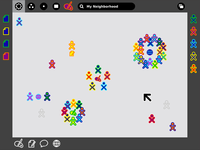 Mock-up of the “neighborhood view” showing children collaborating on various tasks, within the mesh network. By clicking on the icon, communication by Wi-Fi is activated.
Mock-up of the “neighborhood view” showing children collaborating on various tasks, within the mesh network. By clicking on the icon, communication by Wi-Fi is activated.
Countries are expected to remove and add software to best adapt the laptop to the local laws and educational needs. As supplied by OLPC, all of the software on the laptop will be free and open source.[53] All core software is intended to be localized to the languages of the target countries.[56] The projected software as of November 2006[57] are:
- A pared-down version of Fedora Linux as the operating system, with students receiving root access (although not normally operating in that mode).[58]
- The firmware is Open Firmware, a variant of Forth[59]
- A simple custom web browser based upon the Gecko engine used by Mozilla Firefox.
- A word processor based on AbiWord.
- Email through the web-based Gmail service.[14]
- Online chat and VoIP programs.
- Python 2.5 is the primary programming language used to develop Sugar "Activities". Several other interpreted programming languages are included, such as JavaScript, Csound, the eToys version of Squeak, and Turtle Art[60]
- A music sequencer with digital instruments: Jean Piché's TamTam
- Audio and video player software: Totem or Helix.
The laptop will use the Sugar graphical user interface, written in Python, on top of the X Window System and the Matchbox window manager.[59] This interface is not based on the typical desktop metaphor but presents an iconic view of programs and documents and a map-like view of nearby connected users. The current active program is displayed in full-screen mode.[14] Much of the core Sugar interface uses icons, bypassing localization issues. Sugar is also defined as having no folders present in the UI.
Steve Jobs had offered Mac OS X free of charge for use in the laptop, but according to Seymour Papert, a professor emeritus at MIT who is one of the initiative's founders, the designers wanted an operating system that can be tinkered with: “We declined because it’s not open source.”[61] Therefore Linux was chosen. However, after a deal with Microsoft, the laptop will now be offered with Windows XP along with an open source alternative.[62]
Jim Gettys, responsible for the laptops' system software, has called for a re-education of programmers, saying that many applications use too much memory or even leak memory. “There seems to be a common fallacy among programmers that using memory is good: on current hardware it is often much faster to recompute values than to have to reference memory to get a precomputed value. A full cache miss can be hundreds of cycles, and hundreds of times the power consumption of an instruction that hits in the first level cache.”[28]
On August 4, 2006, the Wikimedia Foundation announced that static copies of selected Wikipedia articles would be included on the laptops. Jimmy Wales, chair of the Wikimedia Foundation, said that "OLPC's mission goes hand in hand with our goal of distributing encyclopedic knowledge, free of charge, to every person in the world. Not everybody in the world has access to a broadband connection."[63] Negroponte had earlier suggested he would like to see Wikipedia on the laptop. Wales feels that Wikipedia is one of the "killer apps" for this device.[64]
Don Hopkins announced that he is creating a free and open source port of the game SimCity to the OLPC with the blessing of Will Wright and Electronic Arts, and demonstrated SimCity running on the OLPC at the Game Developer's Conference in March 2007.[65] The free and open source SimCity plans were confirmed at the same conference by SJ Klein, director of content for the OLPC, who also asked game developers to create “frameworks and scripting environments—tools with which children themselves could create their own content.”[66][67]
The laptop's security architecture, known as Bitfrost, was publicly introduced in February 2007. No passwords will be required for ordinary use of the machine. Programs are assigned certain bundles of rights at install time which govern their access to resources; users can later add more rights. Optionally, the laptops can be configured to request leases from a central server and to stop functioning when these leases expire; this is designed as a theft-prevention mechanism.
The pre-8.20 software versions were criticized for bad wireless connectivity and other minor issues.[68]
Desktop environments
Xfce is a lightweight alternative GUI to Sugar. Being only 33 MB (using yum) it does not take up much of an XO's storage space — less than GNOME or KDE. According to the OLPC Wiki: "Xfce is a lightweight but powerful desktop environment that will work well on the XO"[69] Information on installation is available at: OLPC Wiki: Xfce.The XO is also now available dual boot and can run a version of MS Windows.
Gallery
See also
Notes
- ^ "Give one, get one: '$100 laptop' project to sell to public". CBC News. September 24, 2007. http://www.cbc.ca/technology/story/2007/09/24/xolaptops.html. Retrieved 2009-01-07.
- ^ Papert, Seymour (1993). The Children's Machine. BasicBooks. ISBN 0-465-01830-0.
- ^ "Negropontism: A CM1 to 2B1 Backstory". http://www.olpcnews.com/people/negroponte/negropontism_a_cm1_t.html.
- ^ Ward, Mark (September 27, 2007). "BBC NEWS – Technology – Portables to power PC industry". BBC News. http://news.bbc.co.uk/1/hi/technology/7006316.stm. Retrieved 2008-01-25.
- ^ One Laptop per Child. "Vision: Children in the developing world are inadequately educated". http://laptop.org/vision/index.shtml. Retrieved 2008-01-25.
- ^ http://www.ted.com/talks/nicholas_negroponte_on_one_laptop_per_child.html
- ^ "One Laptop per Child: Ways to Give". http://laptop.org/en/participate/ways-to-give.shtml. Retrieved 2009-06-14.
- ^ "OLPC's Software". The OLPC Wiki. One Laptop per Child. http://wiki.laptop.org/go/Our_software#What_software_will_be_used_with_the_.24100_laptop.3F. Retrieved 2007-12-24.
- ^ La última ceibalita, Portal 180, October 14, 2009 (in Spanish)
- ^ UN debut for $100 laptop for poor. BBC, 17 November 2005.
- ^ http://www.olpcnews.com/software/operating_system/microsoft_windows_olpc.html
- ^ Fildes, Jonathan (May 16, 2008). "'$100 Laptop' Platform Moves On". BBC News. http://news.bbc.co.uk/2/hi/technology/7405346.stm.
- ^ http://www.zdnet.com/blog/government/xp-on-xo-negroponte-has-lost-his-bearings/3824
- ^ a b c d For $150, Third-World Laptop Stirs Big Debate. The New York Times, 30 November 2006.
- ^ Jan Melin (November 7, 2007). 100-dollarsdatorn masstillverkas. NYTeknik. Retrieved on December 24, 2007.
- ^ IDG News Service (December 15, 2007), One million OLPC laptop orders confirmed. Itworld.com. Retrieved on December 24, 2007.
- ^ "OLPC manufacturer to sell $200 laptop". Arstechnica. http://arstechnica.com/news.ars/post/20070329-olpc-xo-manufacturer-to-sell-budget-portables-in-developed-countries.html. Retrieved 2007-03-29.
- ^ "One Laptop per Child has no plans to commercialize XO Computer". Business Wire. http://digital50.com/news/items/BW/2001/07/14/20070112005706/one-laptop-per-child-has-no-plans-to-commercialize-xo-computer.html. Retrieved 2007-01-16.
- ^ a b "One Laptop Per Child – XO Giving". OLPC project. 2007-09-23. http://www.xogiving.org/.
- ^ Nystedt, Dan (2008-11-17). "Amazon launches OLPC 'Give 1 Get 1' laptop drive". IDG. http://www.computerworld.com/action/article.do?command=viewArticleBasic&articleId=9120479&intsrc=news_ts_head. Retrieved 2008-11-17.
- ^ Talbot, David (2008-05-21). "$100 Laptop Gets Redesigned". Technology Review. http://www.technologyreview.com/computing/20804/?a=f. Retrieved 2008-12-16.
- ^ http://www.nysun.com/new-york/low-price-laptops-tested-at-city-schools/86861/
- ^ "World's Largest Design Award, Top 6 Winners Announced", Digital Journal, August 25, 2007, http://www.digitaljournal.com/article/220663.
- ^ Index:Award > 2007 > WINNERS 2007 > OLPC XO
- ^ Report on Low-Power PC Research Project. Computer Aid International. 2009. pp. 9. http://www.computeraid.org/pdffiles/Report%20on%20Low-Power%20PC%20Research%20Project%20April%202009.pdf.
- ^ "A conversation with Mary Lou Jepsen", ACM Queue journal, November 1, 2007
- ^ "CL1 Hardware Design Specification". One Laptop per Child. 2008-09-28. http://wiki.laptop.org/images/7/71/CL1A_Hdwe_Design_Spec.pdf. Retrieved 2011-05-16.
- ^ a b "Interview: Jim Gettys (Part I)". LWN.net. June 28, 2006. http://lwn.net/Articles/188060/.
- ^ a b Stephen Shankland (2006-04-04). "Negroponte: Slimmer Linux needed for $100 laptop". CNET. http://www.news.com/Negroponte-Slimmer-Linux-needed-for-100-laptop/2100-7346_3-6057456.html. Retrieved 2007-12-24.
- ^ OLPC team. "Hardware specification 1.5". http://wiki.laptop.org/go/Hardware_specification_1.5. Retrieved 2011-1-19.
- ^ Matthew Humphries. "OLPC XO 1.75 laptop is faster with ARM chip than x86 models". http://www.geek.com/articles/chips/olpc-xo-1-75-laptop-is-faster-with-arm-chip-than-x86-models-20110118. Retrieved 2011-1-19.
- ^ OLPC team. "XO_1.75_A1". http://wiki.laptop.org/go/XO_1.75_A1. Retrieved 2011-1-19.
- ^ Tom Sanders and Paul Briggs (December 5, 2006), Microsoft looking to run Windows on OLPC, VNUnet. Vnunet.com. Retrieved on 2007-12-24.
- ^ "Bug report: WPA/WPA2 not working with Marvell Libertas". http://dev.laptop.org/ticket/584. Retrieved 2007-09-30.
- ^ a b Keyboard layouts for over a dozen languages.
- ^ "Potenco – Products". http://www.potenco.com/products. Retrieved 2008-01-25.
- ^ "One Laptop Per Child". http://laptop.org/en/laptop/hardware/index.shtml. Retrieved 2008-11-18.
- ^ Hardware specification. The OLPC Wiki. Retrieved on 2007-12-24.
- ^ One Laptop per Child. "XO-1.75". http://wiki.laptop.org/go/XO-1.75. Retrieved 2011-08-11.
- ^ http://www.popsci.com/gear-gadgets/article/2008-05/xo-20 XO 2.0. Popular Science Feb 2008
- ^ "Mary Lou Jepsen Bio". Mary Lou Jepsen, Ph.D.. December 3, 2007. http://www.joeinc.tv/bio/bio.htm.
- ^ ""Companies make 5–10% profit from not for profit initiative"". http://texyt.com/OLPC+profit+$100+laptop+manufacturing+notebook+developing+world+negroponte. Retrieved 2008-09-09.
- ^ Negroponte, Nicholas (March 2008). "One laptop per child" (Lecture). http://www.abc.net.au/rn/scienceshow/stories/2008/2192536.htm. Retrieved 1/4 2008.
- ^ "One Laptop Per Child – a Preview of the Hundred Dollar Laptop". Worldchanging. November 3, 2005. http://www.worldchanging.com/archives/003707.html.
- ^ Mary Lou Jepsen. "Our screen, described by its parts". http://wiki.laptop.org/go/Display#Our_screen.2C_described_by_its_parts. Retrieved 2008-06-16.
- ^ Mary Lou Jepsen (May 27, 2008). "Higher resolution than we thought: the XO laptop screen". http://pixelqi.com/blog1/2008/05/27/higher-resolution-than-we-thought-the-xo-laptop-screen/. Retrieved 2009-10-27.
- ^ Klompenhouwer, Michiel; Erno H.A. Langendijk (2008-05-27). "Comparing the Effective Resolution of Various RGB Subpixel Layouts". Los Angeles, California: Society for Information Display Annual Meeting. doi:10.1889/1.3069822. SID08. http://www.sid.org/conf/sid2008/program/symposium.html. Retrieved 2008-06-16.
- ^ Margaret Livingstone; David Hubel (2002). Vision and Art: The Biology of Seeing. Harry N. Abrams. pp. 208. ISBN 0810904063. http://www.worldcat.org/wcpa/oclc/47745847.
- ^ Brooke, James (January 26, 2004). "Technology; E-Mail on Wheels – New York Times". The New York Times. http://query.nytimes.com/gst/fullpage.html?res=9901E1D91738F935A15752C0A9629C8B63. Retrieved 2008-01-25.
- ^ OLPC Keyboard layouts, OLPC Wiki
- ^ ABC. (2008, March 22). The Science Show: One Laptop Per Child. Retrieved May 7, 2008, from [1]
- ^ OLPC (2008, April 21). OLPC Amharic Keyboard. Retrieved May 7, 2008, from OLPC:OLPC Amharic Keyboard
- ^ a b Don Marti (October 27, 2006),Doing it for the kids, man: Children's laptop inspires open source projects, LinuxWorld.com. Retrieved on December 25, 2007.
- ^ a b http://wiki.laptop.org/images/b/b0/KGDMFA001-non-confidential.pdf, 7 March 2011
- ^ http://wiki.laptop.org/go/Disassembly_bottom#Removing_the_ALPS_.28touchpad_and_keyboard_control.29_board, 7 March 2011
- ^ Localization. The OLPC Wiki. One Laptop Per Child. Retrieved on December 25, 2007.
- ^ Software components. The OLPC Wiki. One Laptop Per Child. Retrieved on December 25, 2007.
- ^ "Interview with Jim Gettys, part II". LWN.net. July 6, 2006. http://lwn.net/Articles/189544/.
- ^ a b OLPC – Hardware and Software, Michael Gartenberg, Jupiter Research, 27 April 2007
- ^ Turtle Art is a visual programming language that, like Logo, manipulates an on-screen turtle.
- ^ Stecklow, Steve (November 14, 2005). "The $100 Laptop Moves Closer to Reality". Wall Street Journal. http://online.wsj.com/public/article/SB113193305149696140-442o71jo_IlBrLpyUeeOdsqDs7E_20061113.html.
- ^ Fildes, Jonathan (May 16, 2008). "'$100 laptop' platform moves on". BBC News. http://news.bbc.co.uk/1/hi/technology/7405346.stm.
- ^ "One Laptop Per Child Includes Wikipedia on $100 Laptops; Subset of online encyclopedia to be available in static version to children and teachers in developing world" (Press release). Wikimedia Foundation. 4 April 2006. http://wikimediafoundation.org/wiki/Press_releases/One_Laptop_Per_Child_Includes_Wikipedia_on_$100_Laptops.
- ^ "User talk:Jimbo Wales". Wikipedia. http://en.wikipedia.org/w/index.php?title=User_talk:Jimbo_Wales/archivedecember14&oldid=31599168#.24100_computer.
- ^ "SimCity for OLPC". Slashdot.org. 2007-03-08. http://games.slashdot.org/comments.pl?sid=225694&threshold=1&commentsort=0&mode=thread&cid=18278238.
- ^ GDC: SJ Klein Asks For Serious OLPC Content, Gamasutra Industry News, 6 March 2007
- ^ Electronic Arts. "EA Donates Original City-Building Game, SIMCITY, To One Laptop Per Child Initiative". http://www.ea.com/article.jsp?id=olpc118. Retrieved 2008-01-25.
- ^ http://www.olpcnews.com/software/sugar/criticism_and_rebuttal_on_suga.html
- ^ OLPC:OLPC Wiki
References
- $100 Laptop Nears Launch, SPIE—The International Society for Optical Engineering. The Optics, Photonics, Fibers, and Lasers Resource, July 2006
- $100 laptop production begins, BBC News, July 22, 2007
- $100-laptop created for world's poorest countries, New Scientist, November 17, 2005
- Doing it for the kids, man: Children's laptop inspires open source projects October 27, 2006 Article about how the project’s hardware constraints will lead to better apps and kludge-removal for everyone
- First video of a working “One Laptop Per Child” laptop – demonstration of the first working prototype, by Silicon Valley Sleuth blog
- Hand-cranked computers: Is this a wind-up?, The Independent, November 24, 2005
- "Hardware Specification". OLPC Wiki. http://wiki.laptop.org/wiki/Hardware_specification.
- Laptop with a mission widens its audience, New york times, October 4, 2007
- Make your own $100 laptop…?, Make Magazine, December 2, 2005
- Red Hat "Red Hat Adds Muscle to One Laptop Per Child Movement". http://www.redhat.com/en_us/USA/home/company/news/prarchive/2006/press_oneperchild.html Red Hat. Retrieved 2006-02-01.
- Sugar, presentation of the userinterface – Videostream
- The $100 Laptop: an Up-Close Look – Web video of the first laptop prototype, by Andy Carvin
External links
- Annan presents prototype $100 laptop at World Summit on Information Society (MIT press release)
- Lecture describing the history and practice of the OLPC project Given by N. Negroponte for the American Association for the Advancement of Science, in Boston, March 2007. Recorded and published by the Australian Broadcasting Corporation's Science Show.
- Live-CD
- Negroponte video on dual boot XO
- OLPC Home Page
- OLPC Sugar video 1 – interface emulation demo hosted on YouTube
- OLPC Sugar video 2 – social features demo hosted on YouTube
- OLPC Sugar video 3 – mini Tam Tam demo hosted on YouTube
- OLPC Sugar video 4 – synthLab demo hosted on YouTube
- OLPC.TV videos of the OLPC
- Kirk, Jeremy, "XO laptop to go on sale in 30 countries on Monday", IDG News Service, November 14, 2008
Netbooks Acer Aspire One · Asus Eee PC · Classmate PC · CloudBook · Dell Inspiron Mini · Doel · ECS G10IL · Elonex ONE · Gdium · Gigabyte M912 · HP Mini 1000/Mini-Note · IdeaPad · MSI Wind · Nanobook · Noahpad · OLPC XO-1 · One A110 · Samsung N130/N140 NC10/NC20 · Skytone Alpha-400 · Sony VAIO M series · Sony VAIO W series · Tianhua GX-1C · VIA OpenBook
Comparison of netbooks · Netbook manufacturers · Comparison of netbook-oriented Linux distributions Linux-powered devices Computers
ComponentsAspire One · Averatec Buddy · Classmate PC · CloudBook · ECS G10IL · Eee PC · Elonex ONE/ONEt · Gigabyte M912 · HP Mini 1000/2133 · Inspiron Mini · Doel · MSI Wind · Nanobook · Noahpad · OLPC · One A110 · OpenBook · Skytone Alpha-400 · Tianhua GX-1CAsus Routers · BT Home Hub · Buffalo AirStation · Junxion Box · Linksys WRT54G series · Netgear FVS336G · Netgear DG834G · Picotux · Killer NICOther
Accessories Amazon Kindle · Archos PMA400 · ILiad · Nokia 770 / N800 / N810 · N900 · Pepper Pad · Zaurus · Sony Reader · ZipitMotorola ROKR Z6 / RAZR2 V8 · Neo 1973 / FreeRunner · Nokia N9 · Nokia N900 · Palm Pre · All Android devicesConsolesDefunct/Historical Categories:- One Laptop per Child
- Laptops
- Subnotebooks
- Linux-based devices
- Open computers
- Mobile computers
- Information technology and development
- Free software
- 2005 software
Wikimedia Foundation. 2010.



